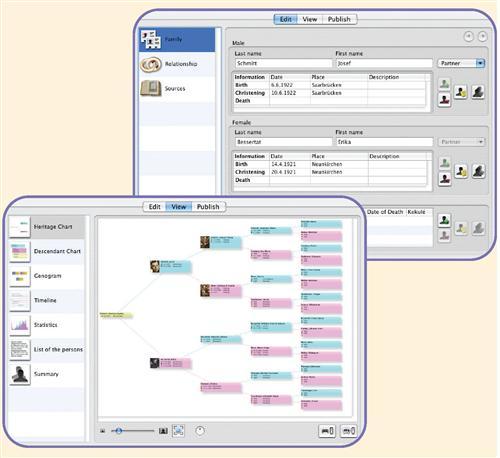Sign up for the Family Tree Newsletter Plus, you’ll receive our 10 Essential Genealogy Research Forms PDF as a special thank you!
Get Your Free Genealogy Forms
"*" indicates required fields
Macintosh buffs don’t merely like their computers — they share a near-religious zeal, in which PC users are heathens and Bill Gates is the devil. But Mac lovers who are similarly addicted to genealogy have long suffered for their faith: Most genealogy software — including market-leading Family Tree Maker — run only on PCs (or on Macs running special PC emulation software).
So Mac-aholics may be saying hosannas at the advent of Mac Family Tree version 4, a downloadable shareware program designed to make the most of the latest Mac OS X operating system. MacFamily-Tree looks and feels like a real Mac program, not just software “ported” over from Windows. As you’d expect on a Mac, its charts and graphics are particularly attractive and flexible. You can drag and drop image files to add photos of your ancestors or even scans of your source material.
For the most part, MacFamilyTree also achieves the Mac’s renowned “ease of use.” Buttons switch between Edit, View and Publish modes. You input all your data in Edit, of course, while View offers options for ancestor charts (called “Heritage Chart”), descendant charts, timelines, genograms, statistical reports, simple lists and summaries. Publish lets you burn family trees to a CD, export to HTML for a Web site or — a slick feature Mac insiders will appreciate — upload to your .mac iDisk on Apple’s servers. You also can export and import GEDCOM pedigree files, once you figure out that importing is Add File or Merge File.
You’ll do most of your work in Edit, though, and here’s where MacFamilyTree occasionally fails to deliver Mac ease of use. For example, you’d expect to be able to double-click on an event to add details or sources — but nothing happens. To elaborate or add a source to a birth or other event, you must click the “Additional Information” icon (unlabeled — it looks like a head with a yellow piece of paper) positioned way to the right, where you’d expect to find a button taking you to the person’s parents. (In fact, that’s what the next one does; Additional Information is riskily sandwiched between the parent button and the Add Person and Delete Person buttons.)
Data entry is similarly un-Mac like. You can’t always Tab from typing a date to the next field, labeled Place; often the whole line turns an uncooperative gray. Make a mistake? You’ll look in vain for a Cancel button (and even OK occurs only occasionally). Nor can the Mac’s famous Undo command save you — it’s grayed out and inoperable most of the time.
Don’t look for solutions to these problems in the Help files, which are scanty even by shareware standards. A search for help on sources, for instance, results in “No matching help topics were found.”
The other oddity about MacFamily-Tree, for American users, is its German origin, which often seeps through even in the English-language version. You may stumble over terms such as referenz, or the requirement of at least a G3 prozessor. The program is big on Kekulé numbers, a German invention we call Ahnentafel.
Devoted Mac addicts will probably want to give MacFamilyTree a try, any-way: You can download a free demo version from <www.onlymac.de/indexe.html>, which will give you a feel for the software and let you do everything but save your files. Version 4 requires a G3 Macintosh or faster and OS 10.2.8 or later. If you try it and like it, registering for a fully enabled version costs $49.
And, no, MacFamilyTree won’t run on a PC. Turnabout, it seems, is fair play.
From the August 2005 Family Tree Magazine
ADVERTISEMENT




